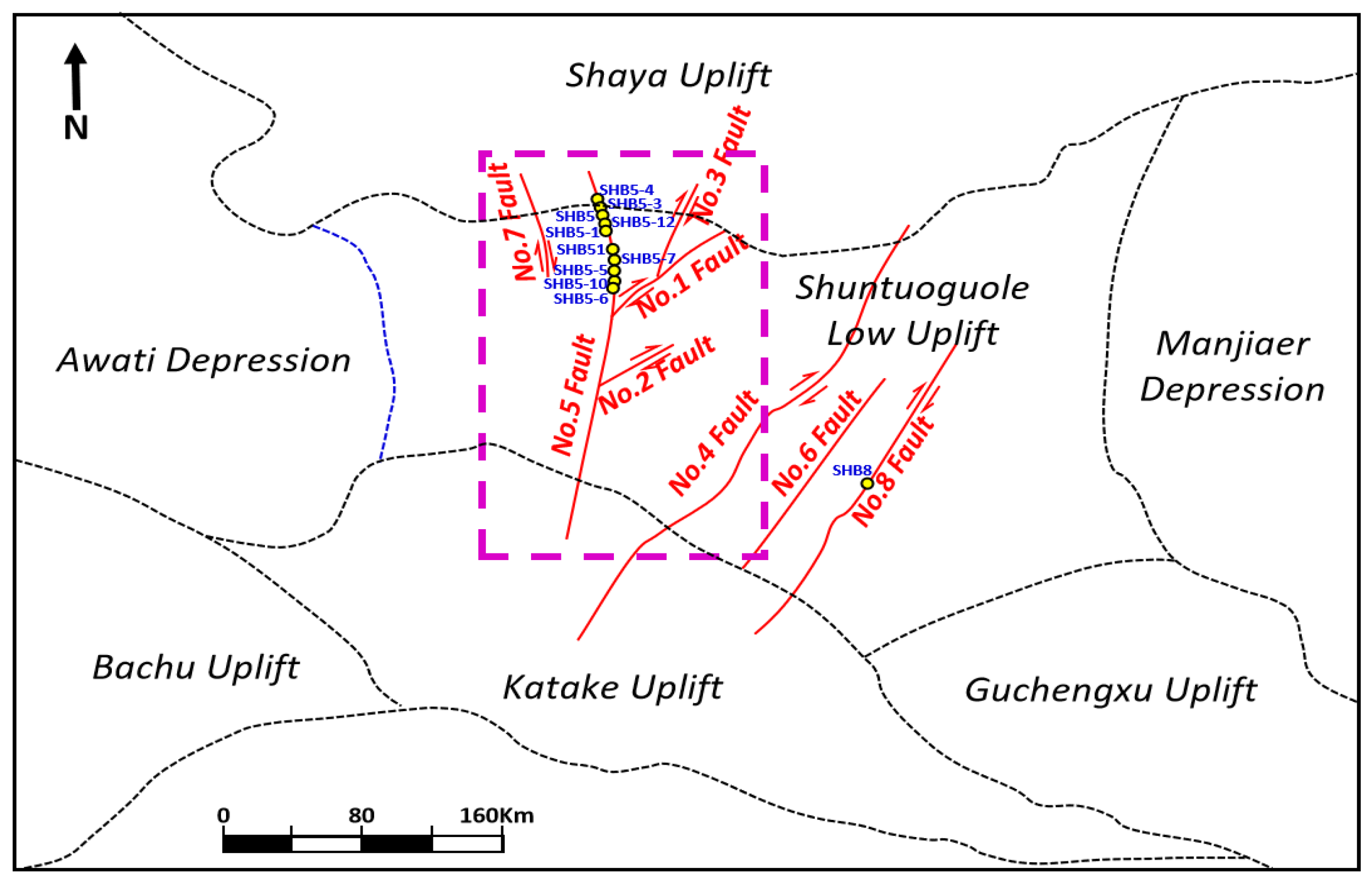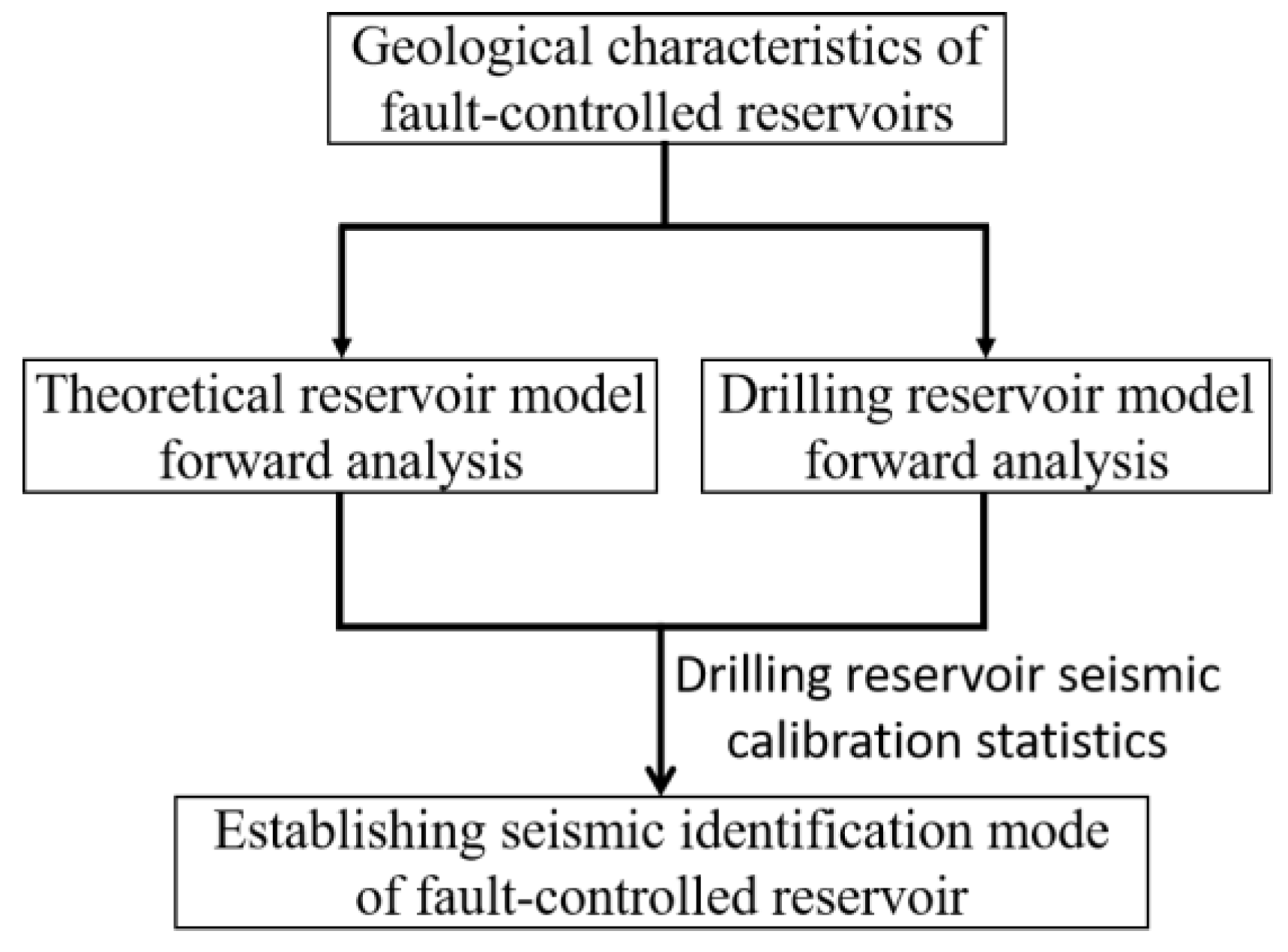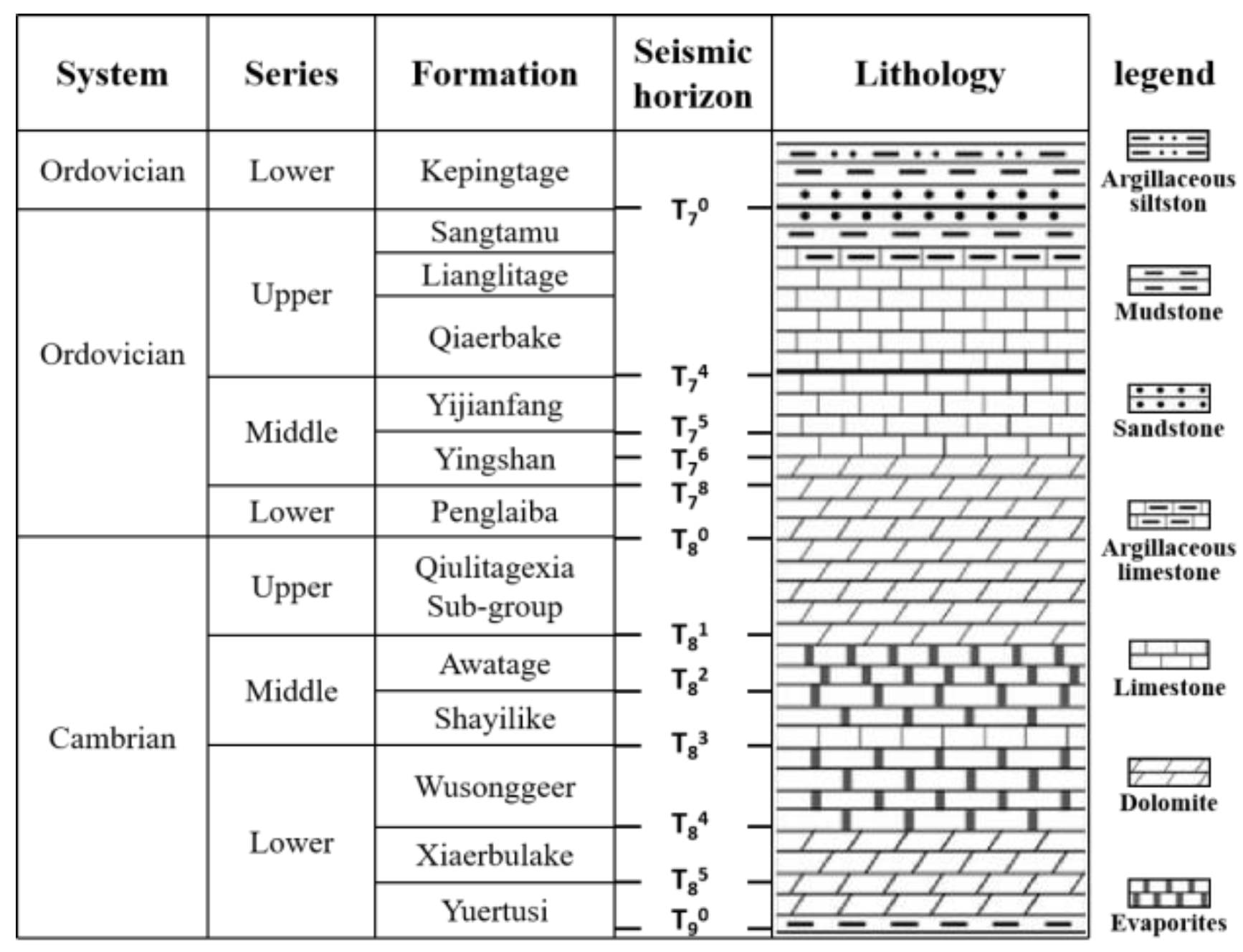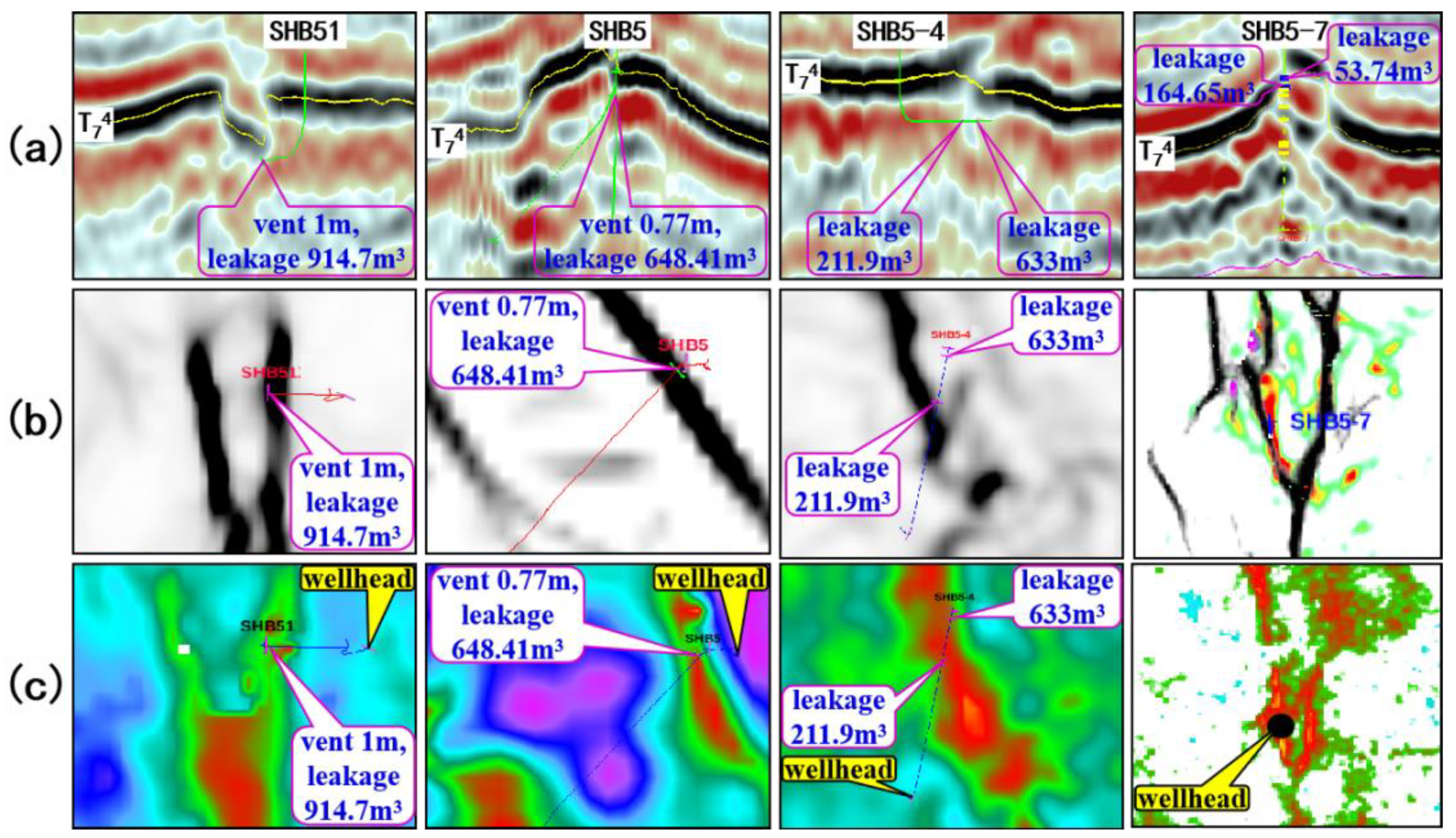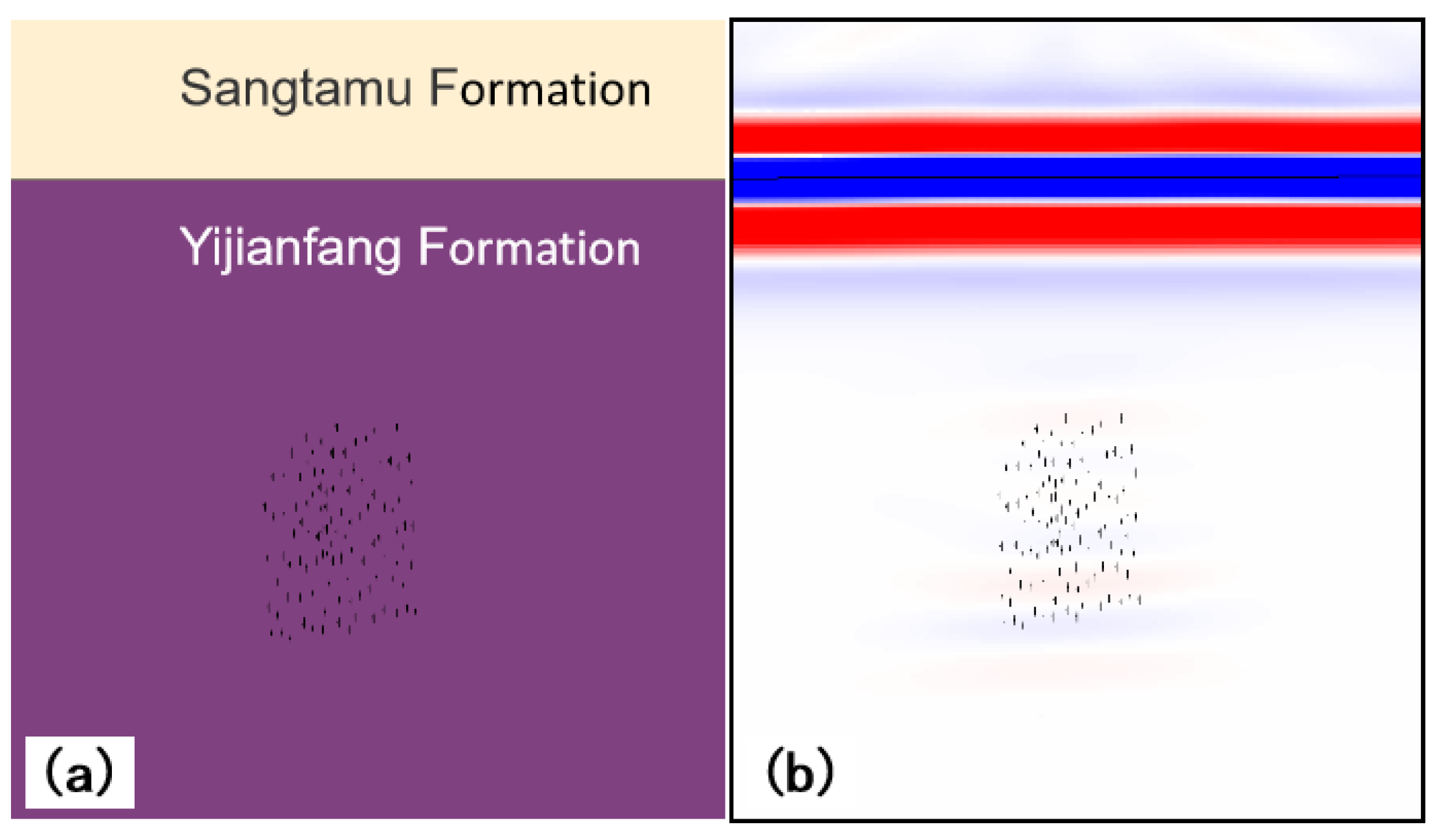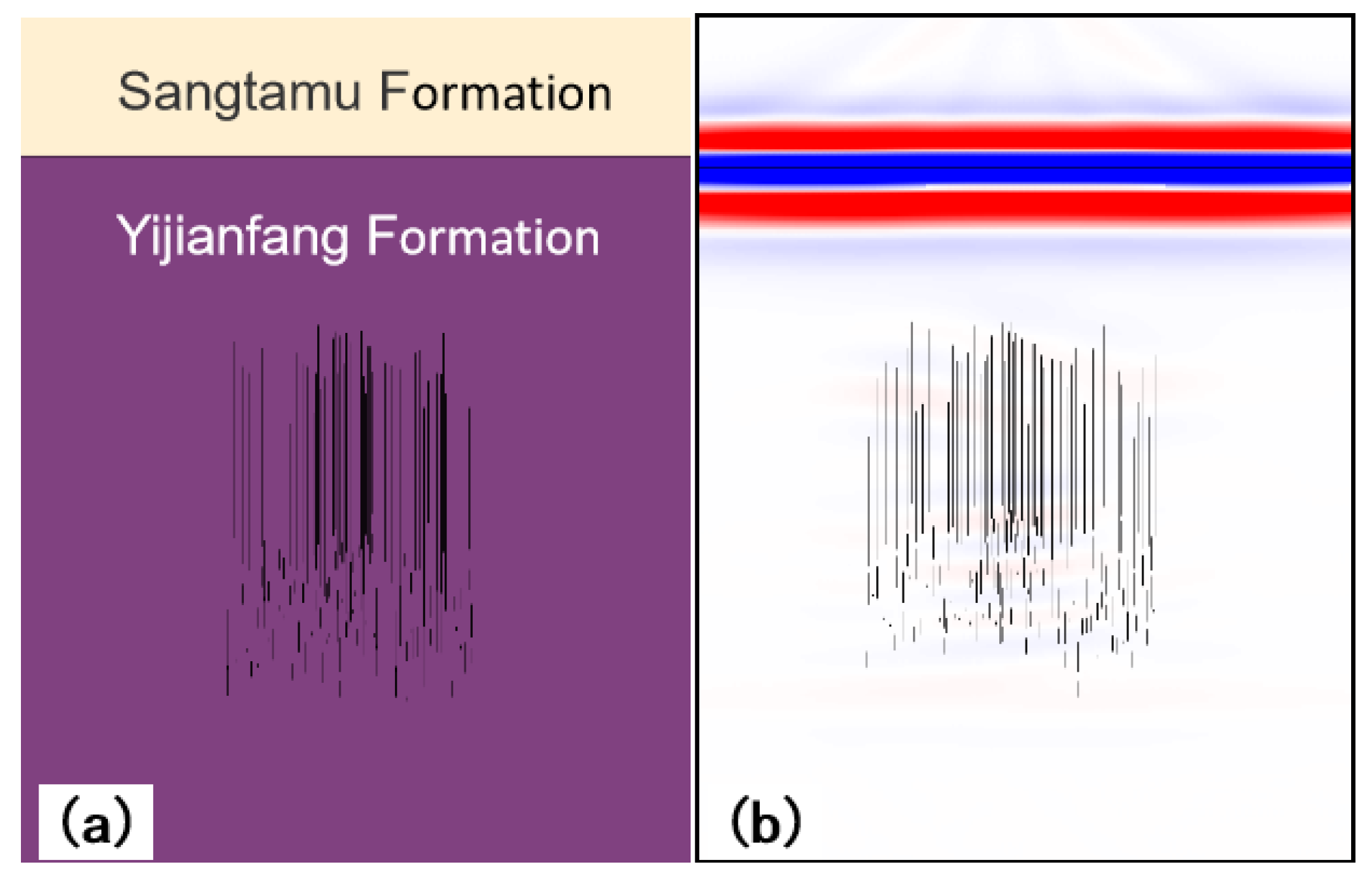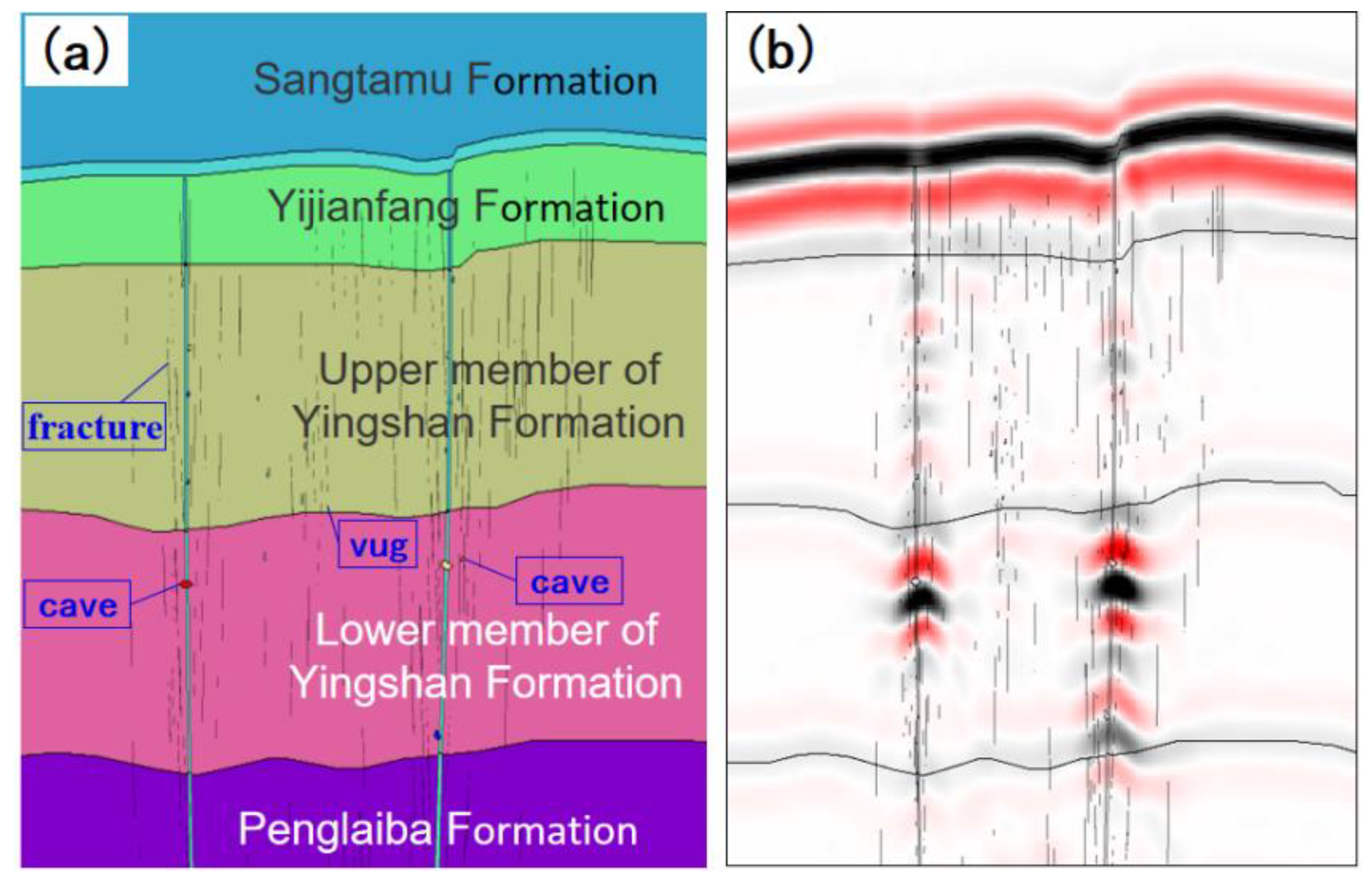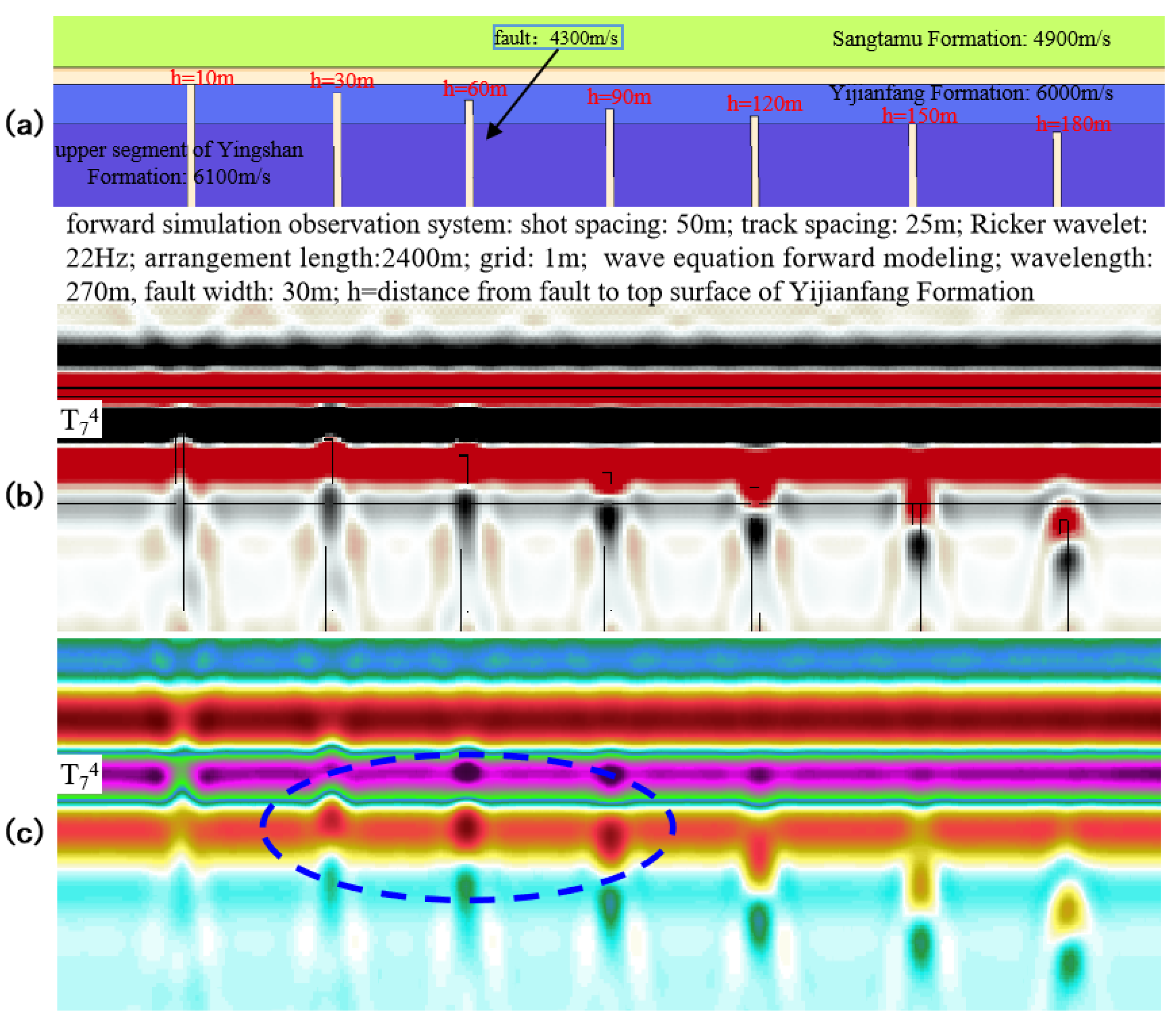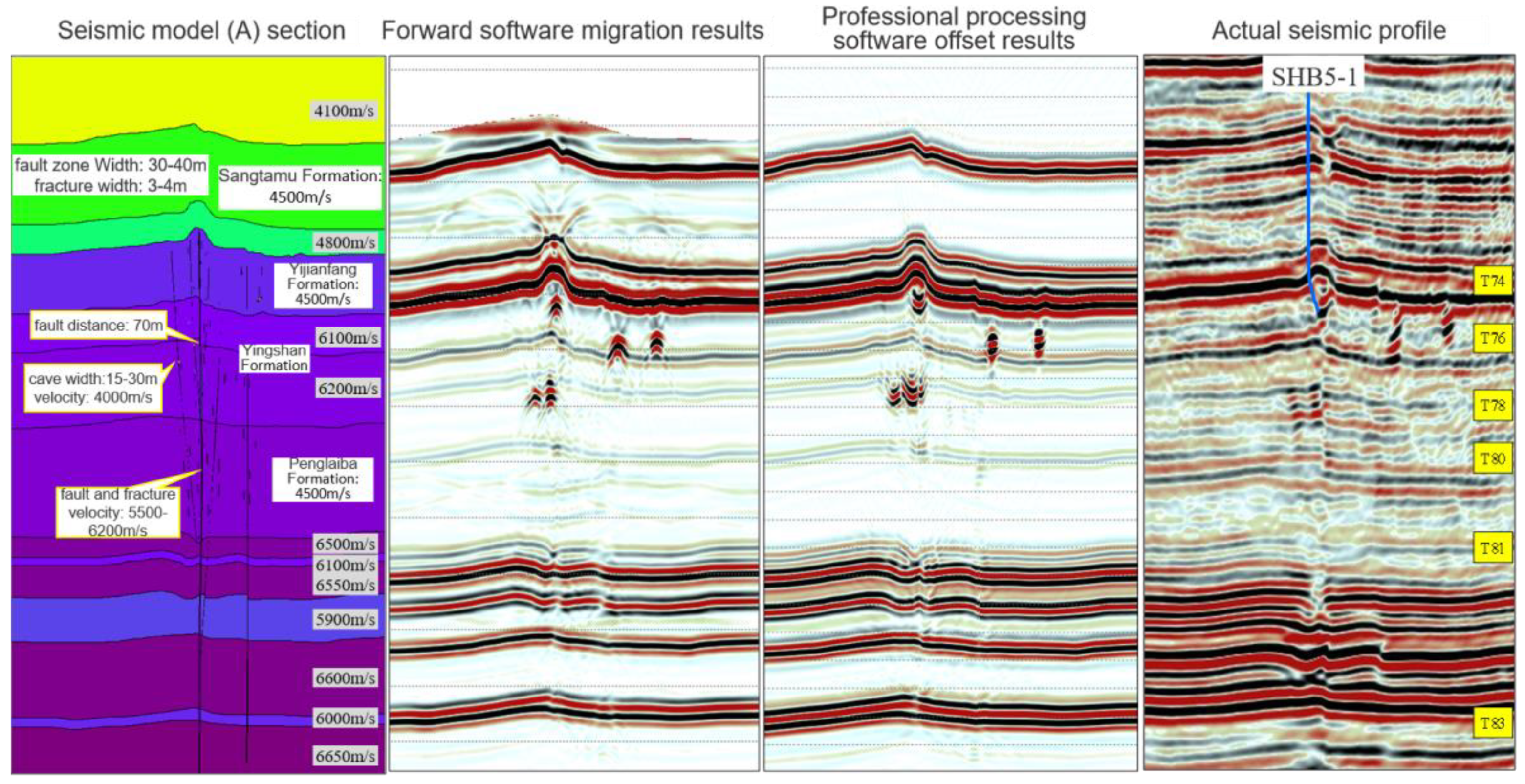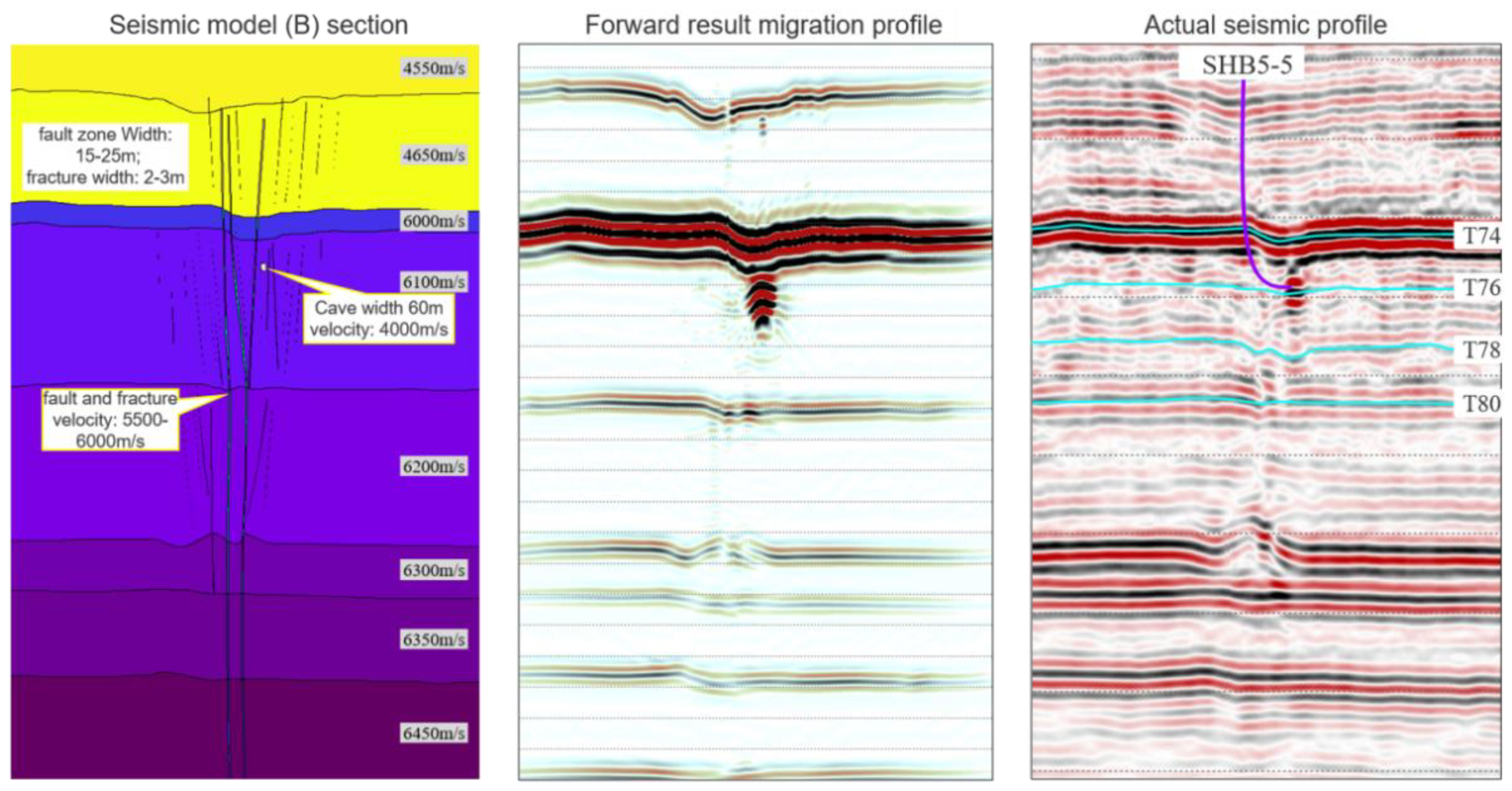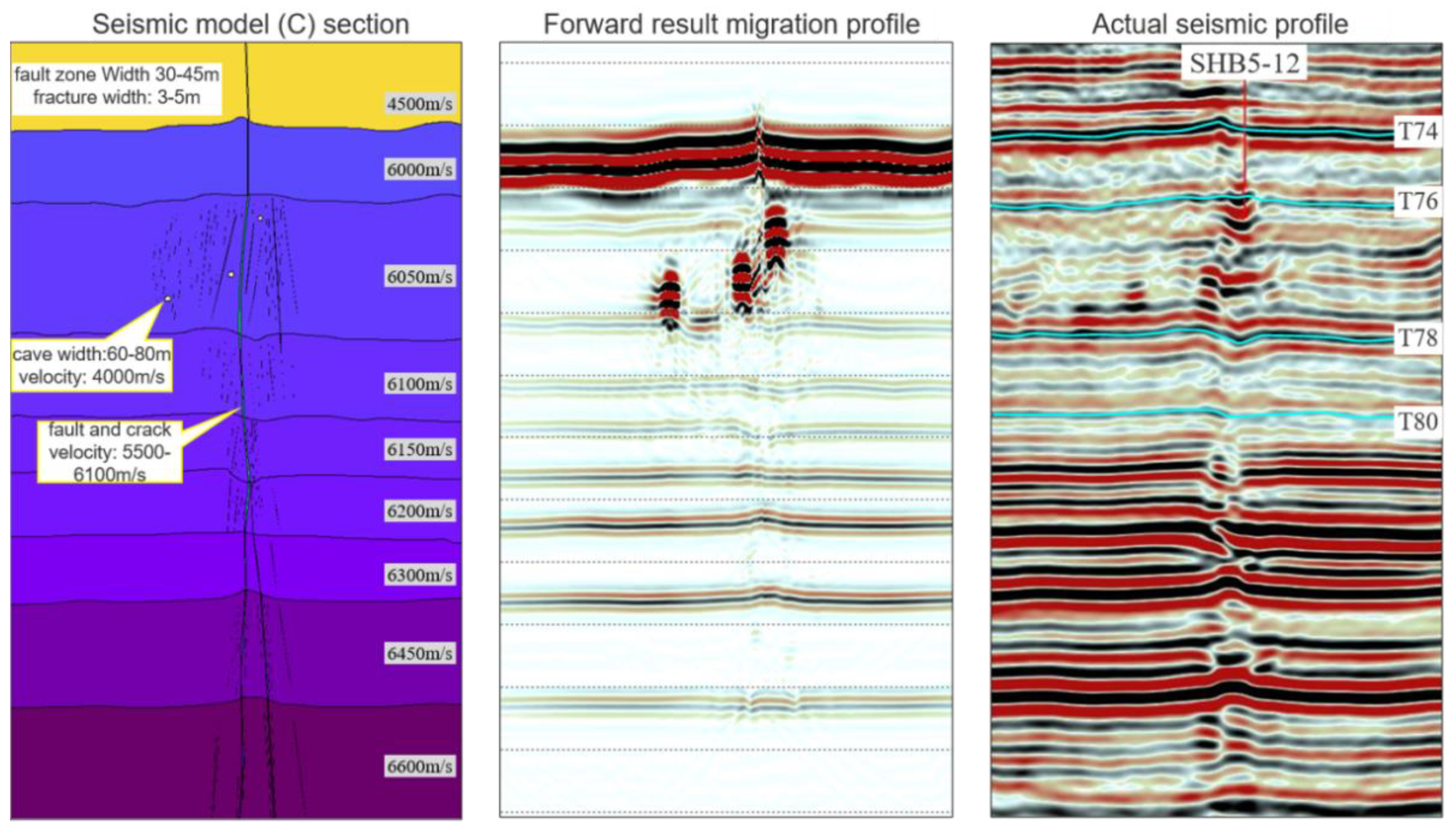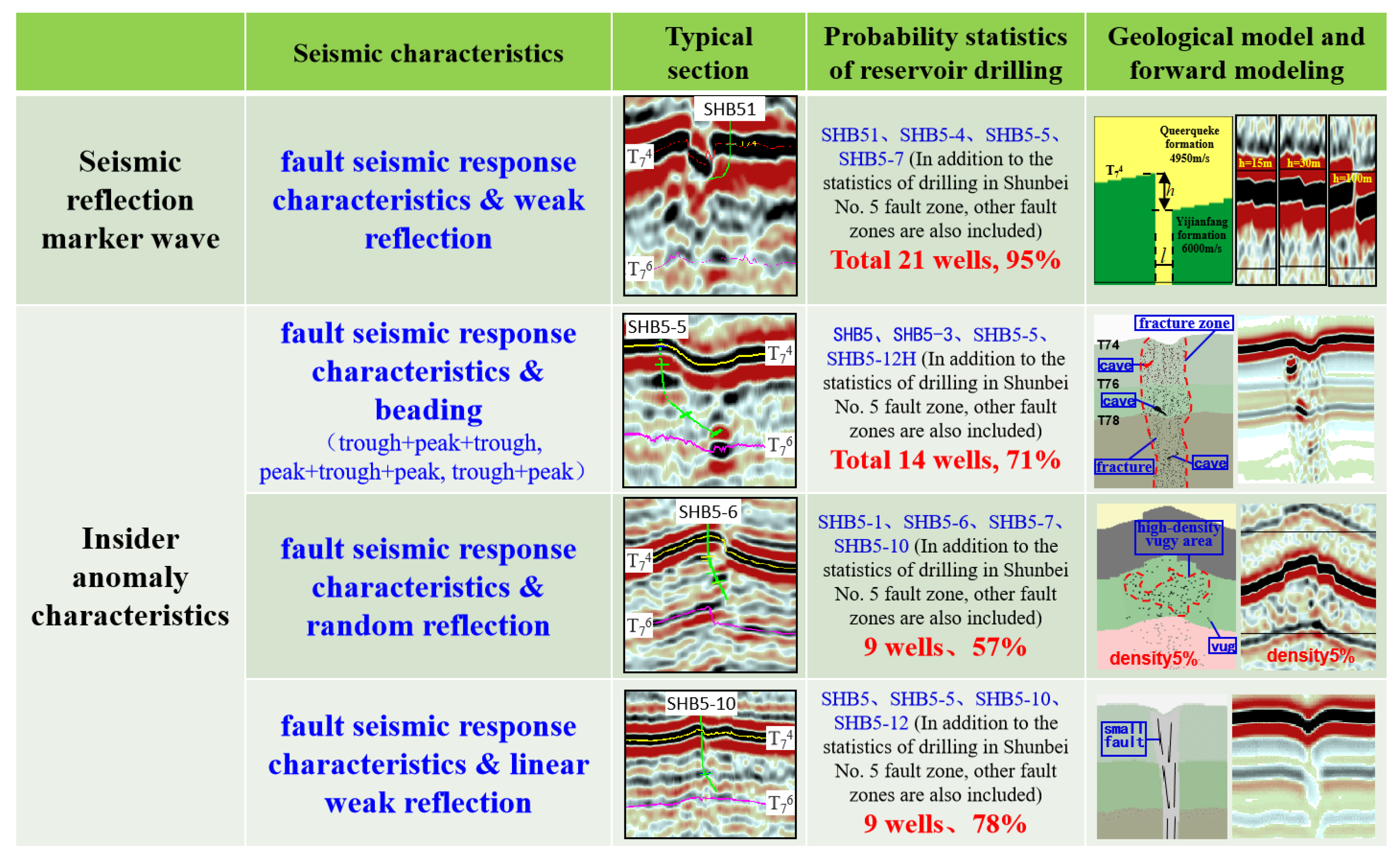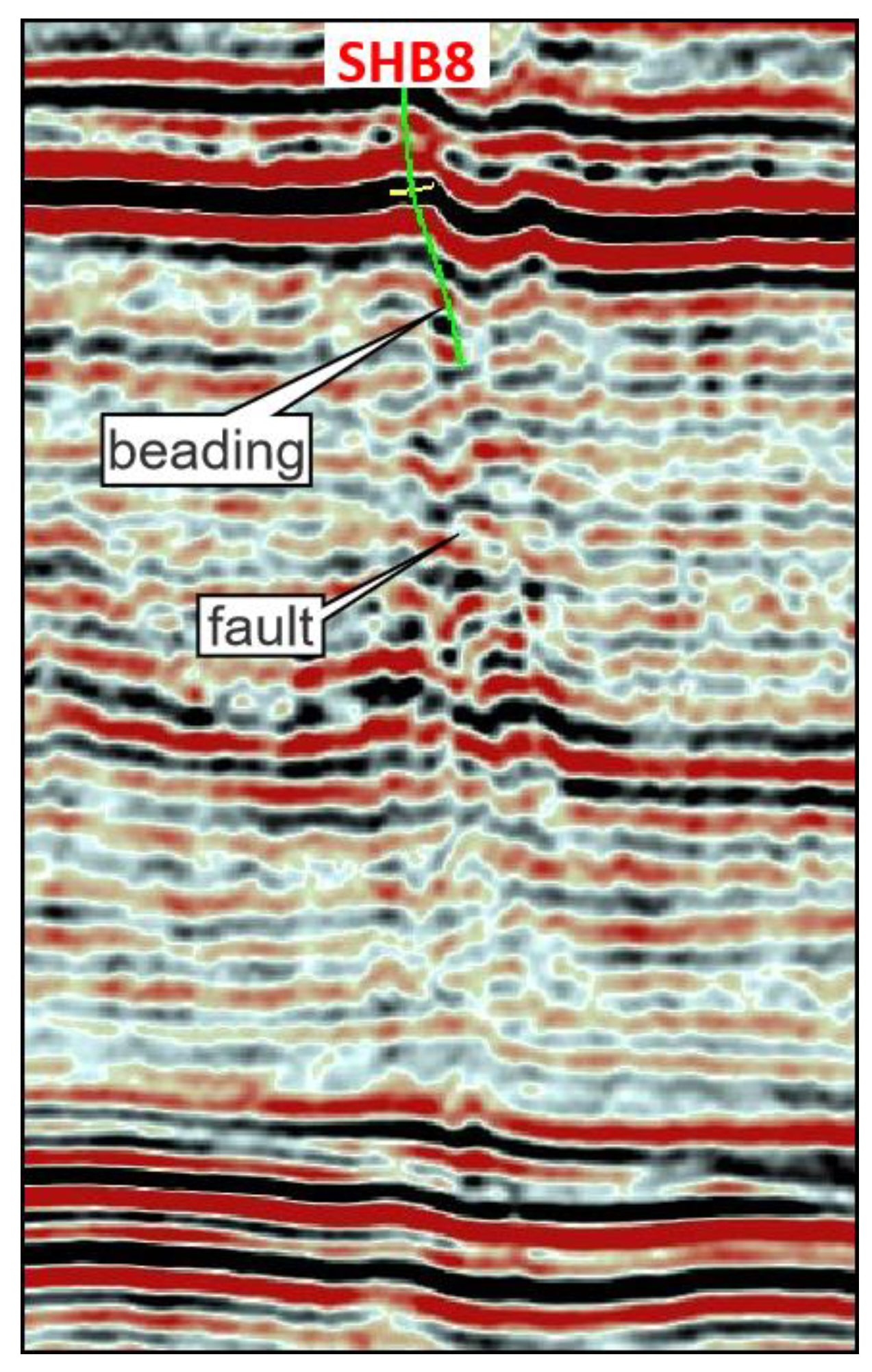1. Introduction
The lower Paleozoic Ordovician carbonate rocks in the large superimposed basin of Tarim are the main exploration fields in the platform basin area. Around the two paleo-uplifts of Shaya and Katake (
Figure 1), Tahe oilfield, Tazhong oilfield and other oil and gas fields dominated by karst fracture caves have been successively discovered [
1,
2,
3,
4,
5,
6,
7]. However, the Shuntuoguole low uplift, located in the low part of the structure between the paleo-uplifts, has been regarded as a “restricted area” for exploration for a long time due to factors such as large buried depth and unclear reservoir forming conditions [
8,
9,
10]. The Shunbei area under study is located in the middle and north of the Shuntuoguole low uplift of the Tarim Basin. The regional structure is located in the structural saddle slope area sandwiched between the Manjiaer depression and Awati depression, and a large number of studies show that the oil and gas accumulation conditions are superior [
11,
12,
13,
14,
15,
16,
17,
18,
19,
20,
21,
22].
Years of exploration practice have proved that the Ordovician carbonate rocks in Shunbei area have the geological background of reservoir development. The fault zone plays a key role in controlling reservoir development and oil and gas accumulation [
23,
24,
25,
26,
27,
28,
29,
30]. The reservoir space type is mainly a fault-controlled karst fracture cave. Among them, Shunbei No. 1 zone, No. 5 zone, No. 7 zone, No. 4 zone (
Figure 1) and other fault zones have made oil and gas discoveries, and built a million-ton oil and gas field [
31,
32]. The Shunbei area has broad exploration and development prospects. However, the study area is completely covered by desert, with a large reservoir burial depth (>7300 m), small strike-slip fault distance, strong reservoir heterogeneity, weak ultra-deep seismic acquisition reflection signal, weak energy, low signal-to-noise ratio, low reservoir imaging accuracy, and unclear reservoir seismic reflection characteristics. It brings many challenges to the understanding of seismic response characteristics and prediction of fault-controlled reservoirs in the Shunbei area [
33,
34], affecting the exploration and development process of this area.
In the early stage, research was carried out in Tarim Basin on seismic response characteristics and the prediction of karst fracture cave reservoirs buried 5000–6000 m. It believed that the seismic identification model of carbonate karst fracture cave reservoirs with strong dissolution mainly displayed strong “string of beads” seismic reflection characteristics. The larger the “string of beads” amplitude energy, the better the physical properties of the reservoir. RMS amplitude and the amplitude rate of change attribute are effective technical means to predict the reservoir. Based on these research results and technologies, Tahe Oilfield has been discovered [
3,
35,
36,
37,
38]. For the Shunbei area, the formation of a fault-controlled reservoir is controlled by many factors. Fault cavities, caves, fractures, and vugs can all be used as good oil and gas reservoir spaces. Multiple reservoir space types are stacked together, and seismic response characteristics are diverse and complex. It is difficult to establish an effective seismic identification model for reservoirs, which further restricts the characterization of fault-controlled reservoirs.
In view of the unclear seismic reflection characteristics of fault-controlled reservoirs and the difficulty of reservoir prediction, this article summarizes the geological characteristics and development mode of fault-controlled fracture cave reservoirs from drilling wells. We study a set of technical processes for establishing the seismic identification mode of ultra-deep fault-controlled reservoirs in the Shunbei area, use the non-uniform medium wave equation and carry out a numerical simulation based on the staggered grid finite difference scheme [
39,
40,
41]. It provides a basis for the interpretation and evaluation of different levels of strike-slip faults and the effective prediction.
In this article, we first investigated the previous research results on the geological characteristics of fault-controlled reservoirs, and combined with the drilling reservoirs seismic calibration in Shunbei area, we clarified the geological characteristics and development mode of ultra-deep fault-controlled reservoirs. We then establish a series of theoretical reservoir models of cave type, vug type, fracture type, equivalent fault-controlled fracture cave type and drilling fault-controlled reservoir models, and the wave equation forward simulation analysis is carried out with parameters that are close to the 3D seismic acquisition. At last, on the forward modeling results, combined with the statistical of seismic facies calibration of the drilling reservoir, we establish a fault-controlled reservoir seismic identification model most consistent with geological understanding in the Shunbei area.
Figure 2 is the research work flow chart.
2. Development Background and Characteristics of Fault-Controlled Reservoir
The Ordovician carbonate strata in the Shunbei area of Tarim Basin vary in thickness from 500 m to 2900 m [
18]. They are generally divided into lower Ordovician (the top of the layer system corresponds to T
78 seismic reflection interface, which is the top of Penglaiba Formation), middle Ordovician (Yijianfang Formation, which corresponds to T
74 seismic reflection interface; the top of Yingshan Formation corresponds to T
75 seismic reflection interface) and upper Ordovician (Qiaerbake, Lianglitage and Sangtamu formations). Except that Sangtamu Formation is a clastic rock deposition, other groups are carbonate sedimentary formations (
Figure 3).
Fault-controlled reservoirs in the Shunbei area are carbonate fracture cave reservoirs developed along the fault zone, which are formed by many factors such as “fault zone, atmospheric fresh water, and deep heat flow”. After being subjected to multi-stage tectonic compression, carbonate rocks develop a certain scale of fracture zone along the deep fault zone [
42,
43]. After multi-stage karst water infiltration along the fault or local hydrothermal upwelling, the small faults and fractures in the fault zone are corroded and transformed to form columnar corrosion pores and cave reservoirs [
44]. This kind of carbonate reservoir is obviously controlled by the strike-slip fault zone, and the scale of the fault zone is one of the most important factors affecting the reservoir scale [
2,
30,
45].
The large strike-slip fault zones are easy to be interpreted and discovered in 3D seismic data. For finding oil and gas with industrial value, we need to find large-scale reservoir targets, which requires us to know the response characteristics of the reservoir controlled by the strike-slip fault zone in seismic data. We selected the drilling data in the Shunbei and adjacent areas for research, hoping to find the geophysical characteristics of the reservoir.
We performed fine seismic calibration on the reservoirs of 41 wells, and counted the seismic response characteristics of the reservoirs. The results show that the fault position and amplitude abnormal reflection are the characteristics of the reservoirs that can be drilled with high probability.
The thick mudstone above the top surface of the carbonate rock formation of the Yijianfang Formation and the limestone in the upper Yijianfang Formation form a "contin-uous strong reflection" seismic response due to the large impedance difference, which is called the T74 wave group. The inner wave formation below T74 interface is “a continuous weak reflection” formed by the carbonate sedimentary surface or lithologic interface. The seismic response characteristics of these two reflection wave groups to faluts, caves, fractures and vugs are inconsistent, so it is necessary to separately statistically analyze the reservoir seismic response characteristics of T74 wave group and interior wave group.
Five wells in the north section of the Shunbei No. 5 fault zone (
Figure 1) drilled to the upper part of Yijianfang Formation (T
74 seismic horizon), and seven fault planes were drilled, of which six had venting or leakage, accounting for 85.7%. These sections are characterized by fracture zone in the Yijianfang Formation, high-quality reservoir connectivity, and high oil and gas production, which are characterized by fault dislocation and weak amplitude of the seismic wave group (
Figure 4).
For the reservoir characteristics of the inner wave formation, the surrounding rock outside the fault zone reflects continuously along the layer, and the overall energy is mainly weak. The inner reservoir is discontinuous, which is characterized by various and complex types such as section point, line or sheet, plane point, polygon, and strip. Generally, according to the statistics and induction of drilling wells, the seismic reflection characteristics of the inner reservoir can be roughly divided into four categories: (i) standard beading, (ii) non-standard beading, (iii) linear weak reflection, and (iv) random reflection (
Figure 5). The drilling fluid venting leakage rate varies greatly among different seismic response types, ranging from 50% to 80%. This is not only related to the insufficient statistical sample points, but also to the highly heterogeneous reservoir, which is difficult to classify and depict. From the effect of chaotic reflection drilling in the four categories, clutter is the response of fracture network reservoirs. Fractured reservoirs with low average velocity can form strong reflection, but the reservoir connectivity is poor, so acid fracturing is often required for production.
The seismic response characteristics of the reservoir obtained based on the drilling data statistics in
Figure 4 and
Figure 5 indicate the reservoir sections directly drilled around the drilling, without considering the influencing factors of the carbonate reservoir genesis and the difference of the reservoir space. Ordovician carbonate fault-controlled reservoirs in the Shunbei area are controlled by multiple factors such as fault zone and karst, and the level of fault zone, and fracture cave dissolution are different. In addition, the combination of the fault zone and fracture cave is complex and diverse, resulting in extremely complex seismic response characteristics of the reservoir, which needs to be studied through forward modeling [
46,
47,
48]. We establish the corresponding relationship between fault zone, fracture cavity body, and seismic response characteristics, guide fault zone evaluation and reservoir prediction, and provide support for optimizing favorable targets.
3. Methods—Theoretical Model and Analysis of Seismic Response Characteristics
The distribution of deep Ordovician reservoirs in the Shunbei area is closely related to the main strike-slip faults and secondary (concealed) faults associated with the main fault activities. The internal structure of fault-controlled is very complex, including caves, vugs, fractures and their combinations. The reflection characteristics of reservoirs on seismic profiles are mostly the comprehensive response of several reservoir types [
10]. In order to clearly understand the seismic response characteristics of various reservoirs, combined with drilling, logging and seismic interpretation data, the theoretical models of various reservoirs are established according to the Ordovician stratigraphic structure and petrophysical parameters of each formation in the Shunbei area. The petrophysical parameters of the formation are shown in
Table 1.
In the Ordovician carbonate strata of Tarim basin, caves are cavities formed by rock fragmentation caused by fault activities or karst caves formed by supergene karstification. They have good physical properties and are the main type of carbonate reservoirs [
49,
50,
51]. According to the stratigraphic structure and petrophysical parameters of the Shunbei area, a group of geological models of caves are designed. It is considered that the caves are not completely fluid filling and may contain some mud. Therefore, the parameters of the cave are designed as follows: velocity is 3000 m/s, density is 2.2 g/cm
3, height is 50 m, and the width increases from 10 m to 400 m, as shown in
Figure 6a. In order to more realistically simulate the seismic response characteristics of the medium to guide the interpretation of actual seismic data. The parameter setting of forward simulation refers to the actual field 3D seismic acquisition system, in which the shot spacing is 50 m, the track spacing is 50 m, the arrangement length is 3200 m, the minimum shot offset is 50 m, and the dominant frequency of Ricker wavelet is 22 Hz. The forward simulation analysis is carried out by using the numerical simulation technology of acoustic equation based on the staggered grid finite difference scheme [
52]. The forward simulation section of cave type reservoir is shown in
Figure 6b, which is the projection of cave shape onto the seismic section. According to the analysis from the
Figure 6, the seismic response characteristics of the cave are strong beaded reflection, the reflected energy is related to the horizontal size of the cave, and the spatial size of the cave is much smaller than the inclusion of beaded reflection.
The vuggy reservoir is one of the main reservoir types in the Shunbei area, and the distribution of pores in fault-controlled reservoirs also accounts for a large proportion. Based on the previous research results, the theoretical model of the vuggy reservoir is established, as shown in
Figure 7a. Considering the requirements of an analog amplifier, software and hardware, the vugs are designed as an aggregate. The single vug size is less than 1 m, the space is unevenly distributed, the hole velocity is 4500 m/s, the density is 2.42 g/cm
3, and the background stratum is limestone. The forward simulation parameters are the same as the cave model, and the mesh size is 0.5 m. The forward modeling section of a vuggy type reservoir is shown in
Figure 7b, which is the vug geological model superimposed on the forward seismic section, and the vugs are randomly distributed within 100 m. From the analysis of a forward profile, the vuggy reservoir is characterized by weak chaotic reflection.
The strong activity of strike-slip faults is also accompanied by the generation of fractures, especially the fractures around the main faults which are relatively developed. It is also a type of reservoir in the Shunbei area and is likely to be an oil and gas reservoir space. The design of the fracture model is also considered as an aggregate. The fracture width is less than 1 m and the height is 200 m, as shown in
Figure 8a. The fracture density within 400 m of the fracture development area is unevenly distributed, the fracture velocity is 5100 m/s, the density is 2.51 g/cm
3, and the background stratum is limestone. The forward simulation parameters are the same as the cave model, and the mesh size is 0.5 m. The forward modeling section of the fractured reservoir is shown in
Figure 8b. The geological model of the fractured reservoir is superimposed on the forward seismic section. The fractures are vertically distributed within 400 m, and the fractures on the forward section are also a weak random reflection.
In actual formation, the probability of single reservoir type is small, and most of them are complex combinations of several reservoir types. Fault-controlled reservoirs in the Shunbei area are also the combination of several reservoirs, which are characterized by different spatial structures, variable combination types and different sizes. Therefore, the fault-controlled fracture cave reservoir is designed as shown in
Figure 9a. The stratum is from Sangtamu Formation to Penglaiba Formation. The width of two fault zones is 20 m. Caves, vugs, and fractures are distributed around the fault zone. The size of caves is 10~20 m, the size of holes is less than 1 m, and the width of fractures is less than 1 m. The reservoirs are randomly combined in disorder. The petrophysical parameters are shown in
Table 1. The forward simulation parameters are the same as the cave model, and the mesh size is 0.5 m. The forward modeling section of the fault-controlled fracture cave reservoir is shown in
Figure 9b, which is the superposition of geological model and forward modeling section. From the analysis of the figure, the reflection anomaly is the comprehensive response characteristic of the reservoir. The cave reservoir is a strong beaded anomaly reflection, and the vug and fracture reservoir are a medium weak chaotic anomaly reflection.
4. Results
4.1. Fault-Controlled Fracture Cave Reservoir Model and Seismic Response Analysis of Yijianfang Formation
We further study the relationship between the fault-controlled fracture cave reservoir of Yijianfang Formation and T
74 reflected wave group, mainly considering the influence of distance between the reservoir top and T
74. According to the analysis of drilling, logging and oil and gas production testing data, as well as seismic and geological knowledge in this area, a fault-controlled fracture cavity reservoir model of Yijianfang Formation as shown in
Figure 10 is established. The thickness and velocity of each layer are consistent with the theoretical model (
Table 1). We design 7 fault-controlled fracture cave reservoirs at different distances from the top surface to the top of Yijianfang Formation. Through forward modeling analysis, a comparative study on seismic response wave field characteristics was generated by different positions of fault-controlled fracture caverns.
In order to facilitate the research and reduce the interference of multiple factors, the cavity body of fault-control fracture is equivalent to a velocity homogeneous body. The width of the 7 fault-control reservoirs is 30 m, and the filling equivalent velocity is 4300 m/s. The distances are 0 m, 30 m, 60 m, 90 m, 120 m, 150 m, and 180 m, respectively. The wave equation of inhomogeneous medium is used for forward modeling calculation, and the simulation parameters are the observation system close to the 3D seismic data acquisition in the Shunbei area. The parameters are a shot spacing of 50 m, a track spacing of 25 m, an arrangement length of 2400 m, and a calculation grid of 1 m. The seismic excitation wavelet is the Ricker wavelet with the dominant frequency of 22 Hz. Shot records acquired by forward simulation are processed by migration imaging method.
The forward modeling results are shown in
Figure 10. When the top surface of the reservoir coincides with the top surface of Yijianfang Formation or is less than 30 m, the T
74 seismic horizon and the seismic trough (red) below it all show the characteristics of weak seismic reflection amplitude. When the top surface of the reservoir is 30~150 m away from the top surface of the Yijianfang Formation, the reservoir is mainly characterized by an abnormal amplitude of seismic trough (red) below the T
74 seismic horizon. As the top surface of the reservoir is farther away from that of Yijianfang Formation, the reservoir shape changes from convex to concave in the seismic wave trough (red) below the T
74 horizon, and the amplitude energy becomes stronger. When the top surface of the reservoir is very far from the top surface of the Yijianfang Formation and enters the Yingshan Formation, it mainly displays the “string of beads” reflection feature.
4.2. Model Establishment and Seismic Response Characteristics Analysis of Fault-Controlled Fracture Cave Reservoir in Ordovician of Shunbei Area, Tarim Basin
According to the structural style difference of the strike-slip fault zone and the geological mode of the fault-controlled fracture cavern reservoir in the Shunbei area, different fault styles and fracture cavern combination models are designed. Based on seismic, drilling, and geological data, the width, filling style, and filling velocity of the fault-controlled fracture cave are reasonably designed. Additionally, a forward model, which is consistent with the actual drilling reservoir development, is obtained for research.
A total of 10 groups of seismic forward models are designed this time, and the observation system is designed with reference to seismic acquisition parameters. The parameters are described as follows: track spacing is 50 m, shot spacing is 50 m, and the arrangement length is 6000 m. Wave equation is used to simulate the field shooting acquisition, the calculation grid is 2 m, the middle shooting is conducted, and the dominant frequency is 22 Hz wavelet.
The forward model A (
Figure 11) is designed as a compressional strike-slip fault with reference to the seismic profile passing through well SHB5-l and perpendicular to the fault zone. The fault distance of the main fault is 70 m in the Yingshan Formation. Multiple branch small faults, fractures, and vugs are designed near the fault zone from the Yijianfang Formation to the Penglaiba Formation, and multiple caves with a width of 10–30 m are designed near the fault zone. Through field outcrop geological research, fault interpretation and prediction of seismic profile, horizontal drilling speed change and other methods in the Tarim Basin, the fault zone width is determined to be 30–40 m, and the fracture width is determined to be 3–4 m by reference to seismic resolution, grid size used to calculate forward model, equivalent scale of the fracture zone and other factors. Fractures are randomly distributed in the reservoir development zone. The equivalent velocities corresponding to different formations and reservoirs are obtained according to the drilling core and logging statistics, and that corresponding to caves and fault zones are 4000 m/s and 5500~6200 m/s.
The forward modeling results show that the cave reservoirs interior of Ordovician are mainly characterized by strong amplitude “string of beads” reflection, and the strike-slip fault in the Yingshan Formation has obvious seismic event dislocation due to large vertical fault displacement. It is mainly characterized by “linear weak reflection” in the area where faults and fractures are densely developed, and it is also characterized by “chaotic facies” reflection in the area where pores are developed. The forward modeling results are in good agreement with the actual seismic profile.
The forward model B (
Figure 12) is designed as a downward strike-slip fault with reference to the seismic profile passing through well SHB5-5 and perpendicular to the fault zone. The two main strike-slip fault zones are approximately parallel. A number of branch minor faults and fractures are designed near the fault zone from Yijianfang Formation to Penglaiba Formation, and a cave with a width of about 60 m is designed. The determination standard of the fault zone and fracture width is the same as that of model A, but slightly different according to different drilling characteristics.
The forward modeling results are in good agreement with the actual seismic profile. The cave reservoirs interior of Ordovician are mainly characterized by strong amplitude “string of beads” reflection, and the fault fracture development area is mainly characterized by a “linear weak reflection”.
Model C (
Figure 13) is designed as a translational strike-slip fault with reference to the seismic profile passing through well SHB5-12 and perpendicular to the fault zone. Several fractures, vugs development zones and three caves with a width of 60–80 m are designed near the fault zone. The determination standard of the fault zone and fracture width is the same as that of model A, but is slightly different according to different drilling characteristics.
The forward modeling results are in good agreement with the actual seismic profile. The Ordovician inner cave reservoir is mainly characterized by “string beads” reflection with strong amplitude, and the fault fracture development area is mainly characterized by “linear weak reflection”.
5. Discussion
The discovery of fault-controlled fracture cave reservoirs in the Shunbei area has confirmed the huge exploration potential of the large strike-slip fault zone of ultra-deep carbonate formations in the Tarim Basin. The poor quality of seismic data caused by strong reservoir heterogeneity, deep burial depth, surface desert coverage and other factors, as well as insufficient sample points (less than 50 wells can be used to carry out statistical work), make the seismic identification mode of the fault-control fracture cave reservoir unclear and the reservoir difficult to identify. In this paper, based on the statistical results of reservoir seismic characteristics of some wells, and using the forward simulation method to synthesize the theoretical reservoir model and different types of typical through well reservoir models to make up for the lack of drilling can not drill enough seismic facies characteristics, we can finally obtain the seismic identification mode of fault-controlled reservoirs in ultra-deep carbonate, and thus provide a basis for the interpretation and effective characterization of fault-controlled reservoirs.
The seismic response characteristics of the reservoir obtained from the statistics of 41 wells are compared with the results obtained from the forward modeling analysis of the model. The relationship between the strike-slip fault zone, fracture cavity body and the seismic response characteristics is found, and the seismic identification mode of the ultra-deep fault-controlled reservoir in the Shunbei area is established (
Figure 14). The seismic profile in the
Figure 14 is the calibration result of the drilling reservoir. From the seismic profile, we can find different seismic responses reflecting the fault zone and reservoir (such as string beads, weak reflection, random reflection, etc.). Some seismic responses are good reservoirs, while others are not. Some seismic responses are good reservoirs and some are not. We use the collected 41 wells to calculate the probability that the seismic response represents good and bad reservoirs, and then verify with the designed forward model to determine whether the seismic response represents a reservoir or a good reservoir. The forward model simulation results and drilling results in
Figure 14 can be mutually verified.
The seismic response characteristics of a fault-controlled fracture cave reservoir are discussed in two parts: seismic reflection marker wave and insider. The seismic identification mode of seismic reflection wave of fault-controlled reservoir is mainly include two response characteristics: “seismic response characteristics & weak reflection” and “red trough anomaly under T
74 horizon”. The internal seismic identification mode is mainly include three response characteristics: “fault seismic response characte”ristics & random reflection”, “fault seismic response characteristics & beading” and “fault seismic response characteristics & linear weak reflection”(
Figure 14). The “fault seismic response characteristics & beaded” seismic facies is mainly characterized by beaded reflection. The reservoir is located in seismic peak or trough, and the beaded appears in multiple layers, single layers or clusters. The “fault seismic response characteristics & random reflection” seismic facies is characterized by random reflection near the fault. Different from the “fault seismic response characteristics & beads”, the “fault seismic response characteristics & random reflection” seismic facies is irregular in shape. “Fault seismic response characteristics & linear weak reflection” seismic facies reflection features linear weak reflection around the fault zone.
In order to test the accuracy of the seismic identification mode of the fault-controlled reservoir, we found a target of “fault seismic response characteristics & beading” in the No. 8 strike-slip fault zone far away from the study area (
Figure 1). This target was named SHB8 well (
Figure 15). After drilling, industrial oil and gas flow were obtained. Oil test production was conducted with a daily oil production of 76 tons and a daily gas production of 311,300 m
3 at a 7 mm nozzle. The accuracy of seismic recognition mode is verified. In other areas similar to Shunbei, we suggest using this reservoir seismic identification model to find targets near the strike-slip fault zones.
6. Conclusions
The research in this paper shows that the seismic identification model of a fault-controlled reservoir is valuable for the identification and prediction of carbonate reservoirs in the Shunbei area of ultra-deep low-quality seismic data. The relationship between complex reservoirs and seismic response characteristics established by this method provides a basis for identifying and characterizing ultra-deep carbonate fault-controlled fracture cave reservoirs using 3D seismic data. When the number of drilling wells is not enough, it is a quick and effective means to establish a regional reservoir seismic identification model through the forward numerical simulation research of the fault zone, fracture cavity theory and drilling seismic geological model, combined with limited drilling statistics. In the seismic identification model of fault-controlled reservoirs of ultra-deep carbonate formations in the Shunbei area, “fault seismic response characteristics & beading” and “fault seismic response characteristics & weak reflection” are the seismic response characteristics of good reservoirs with high probability, which has also been confirmed in the drilling of the SHB8 well.
The seismic identification model of the Shunbei fault-controlled reservoir provides convenience for interpreters to quickly find good reservoirs on 2D seismic profiles. However, we should also realize that different reservoir structures and combination methods may also show the same seismic response characteristics in seismic data, which may result in some reservoirs we find not being in the previously assumed state. We intend to continue to study the geometric and dynamic differences of different reservoir states but the same seismic amplitude response, and obtaining the reservoir seismic identification and prediction technology will be the direction of subsequent research.
